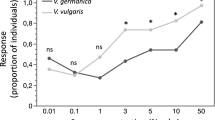Abstract
We tested whether foragers of Vespula germanica leave a chemical attractant at a carbohydrate food site. Foragers were allowed to make 50 or 100 visits to a feeder filled with a rich, unscented fructose solution. We then gave them a choice between this and an identical but unvisited feeder. There was no difference between the number of individuals that chose the visited feeder and those that chose the unvisited one. Instead, wasps showed a tendency to choose a feeder based on its relative position on the feeding stand. We conclude that foragers of V. germanica do not scent-mark food sites. Instead, in the absence of food odor, they rely on local visual cues to relocate carbohydrate food sources.
Similar content being viewed by others
References
Akre, R. D., Green, A., MacDonald, J. F., Landolt, P. J., and Davis, H. G. (1980). Yellow jackets of America North of Mexico, U.S. Department of Agriculture, Agriculture Handbook No. 552, 102 p.
Beier, W. (1983). Beobachtungen und Experimente Zur Orientierung der Deutschen Wespe (Paravespula germanica) am Futterplatz. Zool. Beitr. 28: 321–348.
Butler, C. G., Fletcher, D. J. C., and Watler, D. (1969). Nest -entrance marking with pheromones by the honeybee- Apis mellifera L., and by a wasp, Vespula vulgaris L. Anim. Behav. 17: 142–147.
Cameron, S. A. (1981). Chemical signals in bumble bee foraging. Behav. Ecol. Sociobiol. 9: 257–260.
Chang, V. (1988). Toxic baiting of the Western Yellowjacket (Hymenoptera: Vespidae) in Hawaii. J. Econ. Ent. 81: 228–235.
Chatterjee, S., Hadi, A. S., and Price, B. (2000). Regression Analysis by Example, 3rd edn., Wiley, New York.
D’Adamo, P., Corley, J., Sackmann, P., and Lozada, M. (2000). Local enhancement in the wasp Vespula germanica: Are visual cues all that matter? Insectes Soc. 47: 289–291.
D’Adamo, P., and Lozada, M. (2003). The importance of location and visual cues during foraging in the German wasp (Vespula germanica F.) (Hymenoptera: Vespidae). N. Z. J. Zool. 30: 171–174.
Duncan, C. D. (1939). A Contribution to the Biology of North American Vespine Wasps, Stanford University Publications, Biological Sciences 8 1–272.
Free, J. B. (1968). The conditions under which foraging honeybees expose their Nasanov gland. J. Apic. Res. 7: 139–145.
Jander, R. (1998). Olfactory learning of fruit odors in the Eastern yellowjacket, Vespula maculifrons (Hymenoptera: Vespidae). J. Insect Behav. 11: 879–888.
Jandt, J. M., Curry, C., Hemauer, S., and Jeanne, R. L. (in press). The accumulation of a chemical cue: Nest-entrance trail in the German yellowjacket, Verpula germanica. Naturwissenschaften.
Landolt, P. J. (1998). Chemical attractants for trapping yellowjackets Vespula germanica and Vespula pensylvanica (Hymenoptera: Vespidae). Environ. Entomol. 27: 1229–1234.
Lehner, P. N. (1996). Handbook of Ethological Methods, 2nd edn., Cambridge University Press, Cambridge, UK.
Lloyd, J. E. (1983). Bioluminescence and communication in insects. Ann. Rev. Entomol. 28: 131–160.
Overmyer, S. L. (1995). Scent -mediated recruitment and food-site marking in the German yellowjacket, Vespula germanica (Hymenoptera: Vespidae), Master’s Thesis, University of Wisconsin-Madison.
Raveret-Richter, M. (2000). Social wasp (Hymenoptera: Vespidae) foraging behavior. Ann. Rev. Entomol. 45: 121–150.
Raveret-Richter, M. A., and Jeanne, R. L. (1985). Predatory behavior of Polybia sericea (Olivier), a tropical social wasp (Hymenoptera: Vespidae). Behav. Ecol. Sociobiol. 16: 165–170.
Schmitt, U., and Bertsch, A. (1990). Do foraging bumblebees scent-mark food sources and does it matter? Oecologia 82: 137–144.
Seeley, T. D. (1989). The honey bee colony as a superorganism. Am. Sci. 77: 546–553.
Sharp, J. L., and James, J. (1979). Color preference of Vespula squamosa. Environ. Entomol. 8: 708–710.
Slater, P. J. B. (1973). Describing sequences of behavior. In Bateson, P. P. G., and Klopfer, P. H. (eds.), Perspectives in Ethology, Vol. 1, Plenum, New York, pp. 131–153.
Sokal, R. R., and Rohlf, F. J. (1981). Biometry, 2nd edn., W. H. Freeman, New York.
Steinmetz, I., Schmolz, E., and Ruther, J. (2003). Cuticular lipids as trail pheromone in a social wasp. Proc. R. Soc. Lond. 270: 385–391.
Takagi, M., Hirose, Y., and Yamasaki, M. (1980). Prey -location learning in Polistes jadwigae Dalla Torre (Hymenoptera, Vespidae): Field experiments on orientation. Kontyu 48: 53–58.
von Frisch, K. (1967). The Dance Language and Orientation of Bees, The Belknap Press of Harvard University Press, Cambridge, MA.
Author information
Authors and Affiliations
Corresponding author
Rights and permissions
About this article
Cite this article
Jandt, J.M., Riel, L., Crain, B. et al. Vespula germanica Foragers Do Not Scent-Mark Carbohydrate Food Sites. J Insect Behav 18, 19–31 (2005). https://doi.org/10.1007/s10905-005-9344-x
Issue Date:
DOI: https://doi.org/10.1007/s10905-005-9344-x




